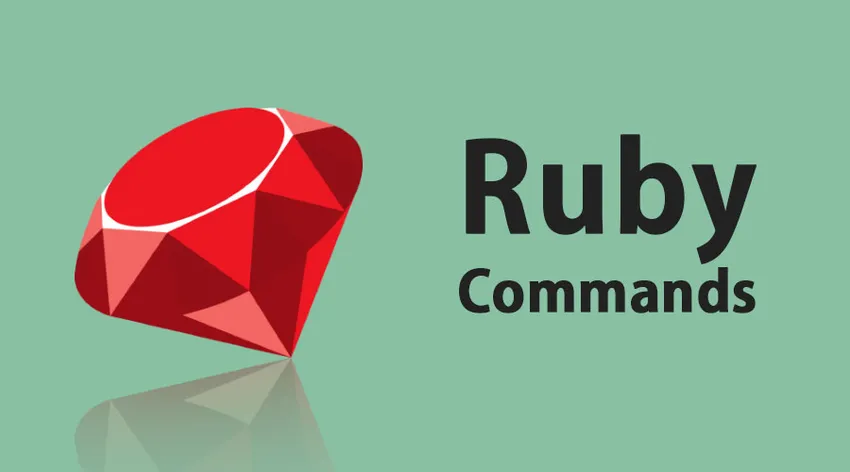
Введення команд Ruby
1. Що таке Рубі?
Ruby - мова програмування з відкритим кодом. Він трактується так само, як і об'єктно-орієнтований. Рубі створив Юкіхіро Мацумото. Рубі названий на честь дорогоцінного каменю, і тому творець пов'язував його як дорогоцінний камінь мов програмування. тут ми обговоримо різні типи команд Ruby.
Дизайн Ruby враховує наступні фактори - простота, розширеність, повнота та портативність. Ruby працює на більшості платформ на базі UNIX. Основна частина Ruby побудована на Linux. Ruby також працює на загальних платформах, таких як Windows, DOS, Mac тощо.
B asic команди Ruby
1. Проста команда для друку рядка в Ruby
#!/usr/bin/ruby –w
puts “Hello, Ruby!”
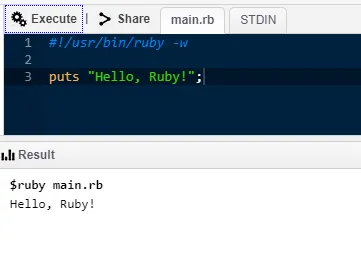
2. Проста команда для друку декількох рядкових рядків за допомогою EOF
#!/usr/bin/ruby –w
print < Multiple line string.
First wayEOF
print <<"EOF"; # same as above
Multiple line string.
Second way
EOF#!/usr/bin/ruby –w
print < Multiple line string.
First wayEOF
print <<"EOF"; # same as above
Multiple line string.
Second way
EOF
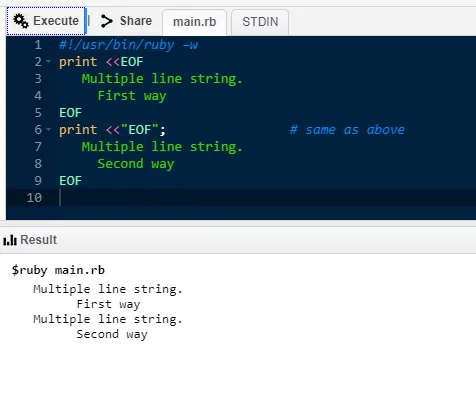
3. Проста команда для друку декількох рядкових рядків за допомогою виконання команди
#!/usr/bin/ruby –w
print <<`EOC` # execute commands
echo First Statement
echo Second Statement
EOC

4. Проста команда для друку декількох рядкових рядків шляхом укладання.
#!/usr/bin/ruby –w
print <<"a", <<"b" # you can stack them
I said foo.
a
I said bar.
b

5. Заява Ruby BEGIN
#!/usr/bin/ruby
puts "This statement comes later"
BEGIN (
puts "This statement will be printed in the beginning"
)

6. Заява Ruby END
#!/usr/bin/ruby
puts "This is main body"
END (
puts "This block executes in the end"
)
BEGIN (
puts "This block executes in the beginning"
)

7. Коментуйте однорядковий коментар
#!/usr/bin/ruby
# This is a single line comment.
uts "This is not a comment" # This is again a single line
comment.
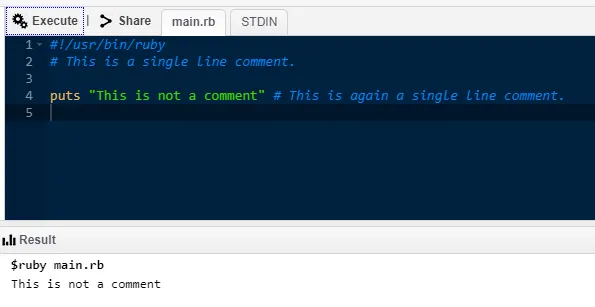
8. Зауважте багаторядковий коментар
#!/usr/bin/ruby=begin
This is a multiple line comment.=end
puts "This is not a comment" # This is a single line comment.

9. Функція члена в класі Ruby. Створення об’єкта та виклик методу.
#!/usr/bin/ruby
class Demo
def testmethod
puts "Hello World!"
end
end
# Now using above class to create objects
object = Demo.new
object.testmethod

10. Глобальні змінні в Ruby
#!/usr/bin/ruby
$globalvariable=123
class FirstClass
def printglobal
puts "Global variable in FirstClass is #$globalvariable"
end
end
class SecondClass
def printglobal
puts "Global variable in SecondClass is #$globalvariable
end
end
class1obj = FirstClass.new
class1obj.printglobal
class2obj = SecondClass.new
class2obj.printglobal
Проміжні команди
1. ЯКЩО… ELSE в Ruby
#!/usr/bin/ruby
x = 1
if x > 2
puts "x is greater than 2"
elsif x <= 2 and x!=0
puts "x is 1"
else
puts "I can't guess the number"
end

2. Справа в Рубі
<#!/usr/bin/ruby
$age = 17
case $age
when 0 .. 17
puts "Not eligible to vote"
when > 17
puts "Eligible to vote"
else
puts "incorrect age"
end
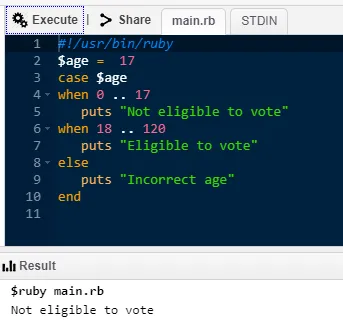
3. Петлі в Рубі
- 3.1. Поки петля
#!/usr/bin/ruby
$i = 0
$num = 10
while $i <
$num do
puts("Inside the loop i = #$i" )
$i = $i + 1
end
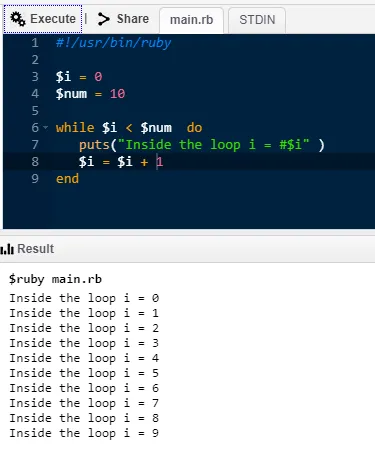
- 3.2. До циклу
#!/usr/bin/ruby
$i = 0
$num = 4
until $i > $num do
puts("Inside the loop i = #$i" )
$i = $i + 1;
end

- 3.3. Для циклу
#!/usr/bin/ruby
for i in 0..9
puts "Local variable value is #(i)"
end
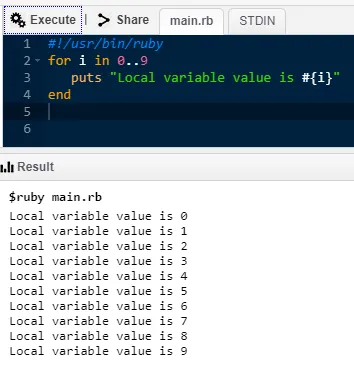
- 3.4. Заява про перерву
#!/usr/bin/ruby
for i in 0..5
if i > 3 then
break
end puts "Local variable is #(i)"
end

- 3.5. Наступна заява
#!/usr/bin/ruby
for i in 0..10
if i < 6 then
next
end
puts "Local variable is #(i)"
end
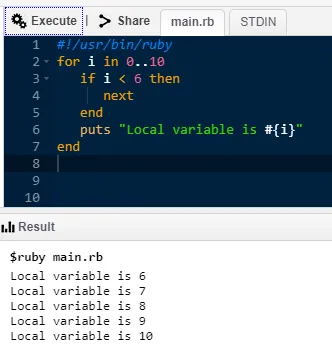
4. Синтаксис методу в Ruby
#!/usr/bin/ruby
def test(a1 = "Noodles", a2 = "Pasta")
puts "The food is #(a1)"
puts "The food is #(a2)"
end
test "Burger", "Pizza"
test

5. Звернення заяви в Ruby
#!/usr/bin/ruby
def testreturn
a = 10
b = 20
c = 30
return a, b, c
endvar1 = testreturn
puts var1
6. Параметризований метод у Ruby
#!/usr/bin/ruby
def sample (*testparam)
puts "The number of parameters are #( testparam.length)"
for i in 0… testparam.length
puts "The parameters are #(testparam(i))"
end
end
sample "Hello", "123", "ABC", "Programming"
sample "World", "456", "Ruby"
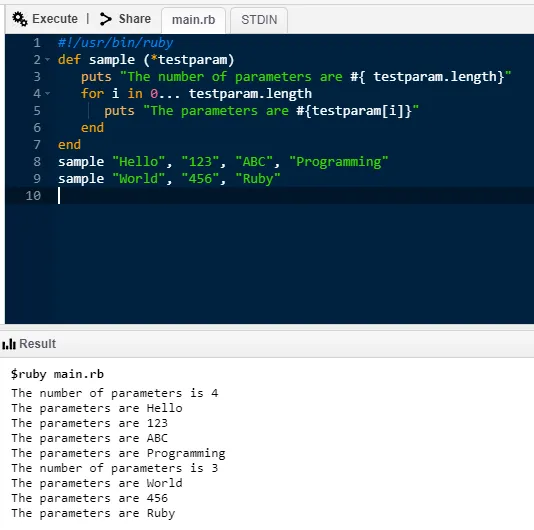
7. Реалізація блоку з використанням заяви про вихід
#!/usr/bin/ruby
def test
yield
end
test( puts "Hello world")

8. БЕГІН і КОНЕЧНІ блоки в Ruby
#!/usr/bin/ruby
BEGIN ( # BEGIN block code
puts "BEGIN code block"
)
END (
# END block code
puts "END code block"
)
# MAIN block code
puts "MAIN code block"

9. Заміна струнного вираження в Рубі
#!/usr/bin/ruby
a, b, c = 1, 2, 3
puts "The value of a is #( a )."
puts "The sum of b and c is #( b + c )."
puts "The average is #( (a + b + c)/3 )."

10. Створення масиву в Ruby
#!/usr/bin/ruby
names = Array.new(10)
puts names.size # returns 10
puts names.length # returns 10
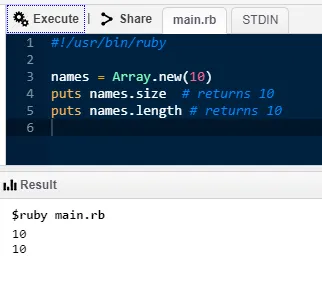
Розширені команди Ruby
1. Методи Геттера та Сетера в Рубі
#!/usr/bin/ruby -w
# defining a class
class Box
# constructor method
def initialize(l, b, h)
@length, @width, @height = l, b, h
end
# accessor methods
def printLength
@length
end
def printBreadth
@breadth
end
def printHeight
@height
end
end
# create
an object
box = Box.new(10, 30, 40)
# use accessor methods
l = box.printLength()
b = box.printBreadth()
h = box.printHeight()
puts "Box Length : #(l)"
puts "Box Breadth : #(b)"
puts “Box Height : #(h)”

2. Написання загальних сценаріїв інтерфейсу шлюзу за допомогою Ruby
#!/usr/bin/ruby "
require 'cgi'
cgi = CGI.new
puts cgi.header
puts "This is a test
3. Програмування розетки за допомогою Ruby
- 3.1. Простий приклад сервера, що використовує Ruby
require 'socket' # Get sockets from stdlib
server = TCPServer.open(8090) # listen on port 8090
loop ( # Running the server infinitely
client = server.accept # Connecting client wait time
client.puts(Time.now.ctime) # send time to client
client.puts "Closing the connection!"
client.close # Client disconnect
)
- 3.2. Простий приклад клієнта, що використовує Ruby
require 'socket' # Get socket from stdlib
hostname = 'localhost' # Set hostname
port = 8090 # Set portsock = TCPSocket.open(hostname, port)
while line = sock.gets # Read lines from the socket
puts line.chop # print with platform line terminator
end
sock.close # Socket closing
4. Багатопоточний приклад в Ruby
#!/usr/bin/ruby
def function1
i = 0
while i<=2
puts "function1 at: #(Time.now)"
sleep(2) i = i+1
end
end
def function2
j = 0
while j<=2
puts "function2 at: #(Time.now)"
sleep(1)
j = j+1
end
end
puts "Started At #(Time.now)"
t1 = Thread.new(function1())
t2 = Thread.new(function2())
t1.join
t2.join
puts "End at #(Time.now)"
Поради та поради щодо використання команд Ruby
Оскільки робота на будь-якій мові програмування вимагає знань та готовності до оновлення, цей випадок не є винятком. Використання основних команд та практикування та оволодіння командами - це ключ до оволодіння цією прекрасною мовою.
Висновок - Команди Рубі
Команда Ruby - це вільна та відкрита мова програмування; він гнучкий і відрізняється великими можливостями. Як випливає з назви, рубін справді є мовою дорогоцінних каменів, яка коштує дуже низько. Можливість підключення та відтворення та легко читабельний синтаксис робить його дуже зручним для користувачів. Це вдосконалене сценарійне обладнання також підсумовує свою популярність.
Рекомендовані статті
Це був посібник для команд Ruby. Тут ми обговорили основні команди Ruby та деякі попередні команди Ruby. Ви також можете переглянути наступну статтю, щоб дізнатися більше.
- Як використовувати команди Selenium?
- Найпопулярніші іскрові команди
- Команди HBase
- Як користуватися командами Tableau?
- Програмування сокетів в Python